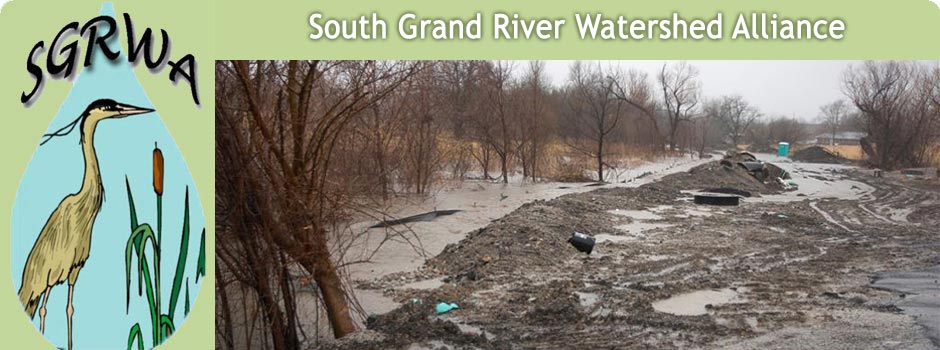With the memory of the recent local floods that have occurred in many areas of the South Grand River Watershed, it is a good time to reflect on actions that individuals can take to help reduce future flood damage.
First, it is important to recognize characteristics of natural streams. A natural stream is free to meander within its floodplain. The meandering serves to reduce the velocity or speed of the water as it moves within the stream channel. The floodplain gives the stream room to spread out. Another component of natural streams is the riparian corridor of natural vegetation that grows along each side of a stream bank. This natural vegetation not only provides essential habitat for quality aquatic life and water, it also slows the stormwaters down before they reach the stream. This slowing of the waters allows time for much stormwater to be absorbed deep into the ground rather than rushing into the waterway.
Straightening and clearing out stream channels, while speeding water through that portion of the channel, causes increased erosion and increased flood damage to downstream communities. It is also detrimental to water quality and aquatic habitat.
Next, learn about and implement features in your landscape that help mimic the natural systems. Probably most homeowners, businesses, schools, government agencies etc. have a space in their landscape for a rain garden or two. Rain gardens are slightly scooped out places, planted with native plants tolerant of very wet or dry conditions. This scooped out space is bermed slightly so rainwater is retained within the rain garden to be slowly absorbed into the ground. A rain garden will absorb 30% more stormwater that a comparable area of lawn.
Another feature that a significant number of places could install is rain barrels that trap runoff from a roof to be used to water plants at a later time. Again, a significant amount of water can be prevented from entering a city’s stormwater system with the use of rain barrels.
Mowing practices are another very important action that has a significant effect on stormwater runoff as well as water quality. Many who have a stream, whether ephemeral or larger, running through their property mow up to the bank of the waterway. Very little stormwater is filtered down into the ground through turf grass and three inches of grass does not do much to slow down the stormwater. If you have such a situation on your property, planting native trees, shrubs, grasses and flowers would be a great contribution to slowing and infiltrating stormwaters. These plants would also alleviate stream bank erosion.
You don’t have to live near a stream bank though to help slow and infiltrate stormwaters. Native plants can be used in nearly any landscape plan or acreage lot. Because native plants have exceptionally long roots that act to channel water, they will serve this purpose wherever they are planted.
